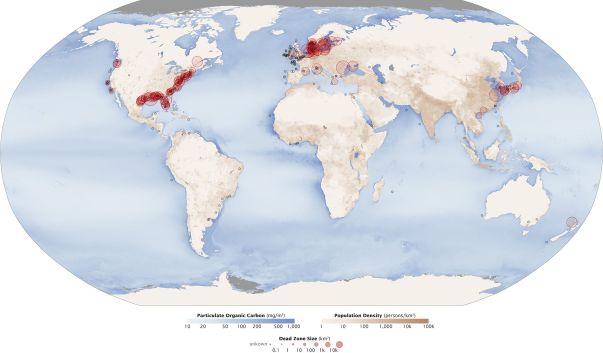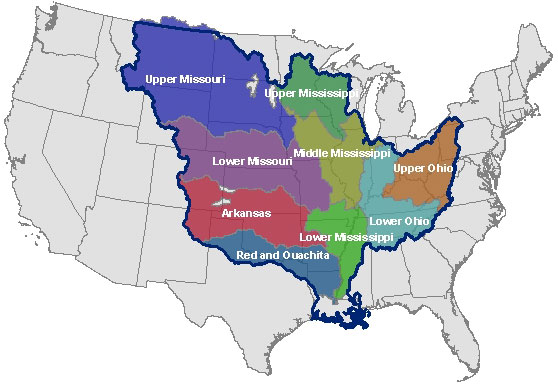By J.P. Kelsey
When the term “dead zone” is heard in reference to the ocean, many things can come to mind, but what are they really and why do they matter? The scientific term for a dead zone is “hypoxia,” which basically means low oxygen levels and that is exactly why they are important to marine ecosystems. It is these low oxygen levels, and the many things that can influence their growth, that can be detrimental to the survival of a wide range of marine life. Although the term can be alarming, a dead zone in the ocean is a normal part of marine ecology and they occur all throughout the world.
It is when these hypoxic zones occur more frequently, are influenced by human activity, and form where marine life typically inhabit that scientists become concerned. These areas are more observable in the Spring/Summer months due to the warmer weather and outside nutrients being introduced more frequently during this time.”My concern falls more with the processes that are creating that [hypoxia] and sustaining it,” said Dr. Jeffrey Krause. “We are dealing with a pretty large and expansive man made hypoxic zone in the Gulf of Mexico.” Krause is an Assistant Professor of Marine Sciences at the University of South Alabama and Senior Research Scientist at the Dauphin Island Sea Lab. There are around 400-500 hypoxic zones in the world, but not all are immediate threats and some are larger than others. The Northern Gulf of Mexico is home to the second largest dead zone in the world and according to NOAA (National Oceanographic and Atmospheric Association), the 2014 dead zone size estimate was around 5,052 square miles.
NOAA and the Louisiana Universities Marine Consortium (LUMCOM) have been monitoring gulf hypoxic areas for about 30 years now. It was in 1972 when lower than normal oxygen levels were first observed and researchers began investigating causes. This year’s gulf dead zone was slightly smaller than in previous years, but it is still roughly the size of Connecticut and there are a few, key factors as to why it remains quite robust. One of the main reasons is that the Mississippi Watershed is home to extensive farmland and this land, which accounts for about 33 percent of the continental U.S., drains from the Mississippi River to the Gulf of Mexico.
Having a lot of farmland in this area isn’t necessarily a bad thing, but starting in the 1950s and ‘60s, the industrialized production and use of soil amendments increased and that has been very influential. Specifically, high concentrations of Nitrogen and Phosphorous in fertilizers are the elements that act as catalysts for many biological processes that contribute to the formation of dead zones. “It’s not that the fertilizer itself is causing it [hypoxia],” said Krause. “The fertilizer is stimulating the production of organic matter. That organic matter, instead of sinking to the sediments and staying there, is being consumed because it’s food and this active consumption depletes oxygen.” Krause went on to explain that it is mostly bacteria that consumes this excess organic matter and is an essential part to the biological phenomenon of hypoxia. But a few other things can come into play to form theses areas. “The stratification of water is already present in the ocean and that makes the exchange of oxygen from one column to the next difficult. Then you have your nutrients and that is where the fertilizer comes into play because it’s fuel. The top layer of water that is warmer and already has phytoplankton becomes more nutrient rich, resulting in a large biomass of organic matter that sinks and is consumed. This process causes the lower layer of water to become more dense and the oxygen that is present in the top layer has an even more difficult time reaching the lower, cooler columns of water.”
The issue of hypoxic zones and their contributing factors becomes even become more complex when you consider the socioeconomic implications that are directly tied to the ocean. “The Northern Gulf of Mexico is a very productive ecosystem. A lot of organisms call this area of the gulf home and use it and, in turn, there are a lot of economic services tied up with that,” Krause added. This could mean anything from large scale fisheries that depend on fish like Red Snapper to independent shrimping being effected. These two industries alone are worth millions of dollars to gulf residents and both could substantially effect the businesses and families that have spent decades depending on a healthy ocean for their livelihood.
The gulf dead zone is only one piece of a larger, environmental problem with U.S. agriculture and watershed issues, however. The gulf just happens to be one of the areas where effects of agricultural practices and pollution are more visible. These kind of problems, though, are far reaching, effect the whole country and are heavily tied to government and industry. “When you start getting into those type of issues, it’s a little more tricky to regulate. Regulation of Nitrogen use and fertilizer, these are some of the things on the table. They have set benchmarks, the National Academy of Sciences have made recommendations; Ultimately, science will recommend the course of action, but it’s going to be policy makers and politicians that will decide how to move forward. This is a complex issue, though, and it’s not a simple regulatory solution where you get rid of one thing and fix another. The pragmatic approach is to take measures to reduce the dead zone size, not eliminate it. And regulating things like nitrogen use can help.”
There are still many obstacles faced when it comes to the relationship between policy, big business, and the environment, though. Science and scientists are largely underrepresented in congress and that can hinder the way in which decisions get made and how quickly action is taken. Some steps have been taken to reduce things like pollution and increase more efficient forms of energy, but there has always been a lag. Until the gravity of the environmental situation becomes more apparent to world leaders, science may only be able to lobby the people.



